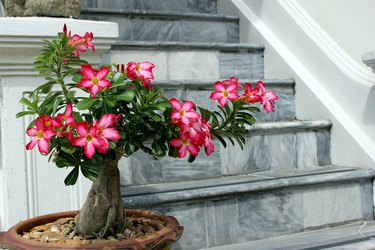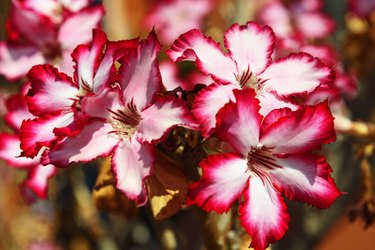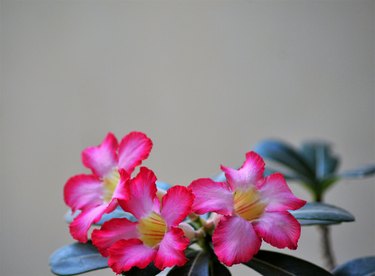
Gardeners can find beautiful blossoms for just about any climate or conditions. Florida gardeners have plenty of beautiful heat-loving options, including the desert rose plant (Adenium obesum). This slow-growing perennial succulent bears glossy deep green leaves that make a striking backdrop for its vivid tubular blossoms. The desert rose is hardy in USDA plant hardiness zones 10b through 12, so many Floridian gardeners have the option of growing them directly in the ground or using them as container plants for a patio or rock garden in areas where cold snaps are common.
What to Know About Desert Roses
Video of the Day
The desert rose produces a profusion of strikingly beautiful flowers. They're available in single, double or even triple-blossom cultivars in vibrant shades of red, pink-white and yellow. The plant's trumpet-shaped flowers show to good advantage because blossoms grow in terminal clusters near stem tips, where they're highly visible and not hidden behind foliage.
Video of the Day

The desert rose is a succulent and forms an irregular, swollen, moisture-storing trunk called a caudex, which is mostly underground. In most of its range, the desert rose typically reaches a height of 4 feet and a width of 3 feet, but in southern Florida it's not uncommon to see it reach 6 feet in height. If you're growing in containers rather than in the ground, you can control the final size of your plant through the pot you choose. Periodic repotting gives plants room to continue growing, and limiting the size of the planter keeps their size and weight manageable (which is important if you'll be moving them indoors in winter).
Warning
The sap of the desert rose plant is highly toxic. Consuming any part of the plant can be dangerous or potentially fatal for pets and humans alike, which is an important consideration for gardeners with pets or toddlers. In fact, it’s part of the dogbane family (Apocynaceae), which was named specifically for its toxicity to canines.
You should avoid letting the sap contact your bare skin, where it can cause contact dermatitis or, more importantly, be absorbed into your bloodstream. Wear gloves when pruning or performing plant care and wash implements immediately after use.
Growing Conditions for Desert Roses
As their common name suggests, desert roses thrive on plenty of heat and sun. In Florida, plant them or position their pots where they'll get at least six hours of full sun per day. They can be grown as shrubs or small trees, and while they're drought tolerant, they do best in moist, well-draining soil. Desert roses cultivated in the ground require consistently free-draining soil and should not be planted near automatic sprinklers to avoid root rot. As with most other succulent plants, they don't like wet feet.

They also don't tolerate frost, so growers in areas of Florida where winter temperatures commonly drop below 35°F should grow desert roses in containers that can be moved indoors. An abrupt change in weather can lead to plants dropping leaves, but that's normal and nothing to worry about.
You can also expect them to go through a period of dormancy when nighttime temperatures are between 39 and 46°F and daytime temperatures drop into the range of 60 to 64°F. That dormant period is a normal part of the growing season in areas with cool winters. Simply withhold water until spring arrives and temperatures rise back above those levels. The plant will drop leaves and look bedraggled while dormant but will bounce right back when weather warms and watering resumes.
Its love of warmth makes the desert rose well suited for use as a houseplant. If you're growing it indoors, select a pot or planter with drainage holes and a potting soil that's intended for succulents. Adenium plants are low maintenance as indoor plants, requiring only enough water and periodic fertilization to flourish. One distinctive and striking option for the desert rose is to treat it as a bonsai plant. The gnarled caudex can be "lifted," or exposed, by washing away soil to a depth of several inches. This gives it the look of an old tree trunk, while pruning back foliage and upper growth will complete its resemblance to a bonsai.

Desert Rose Plant Care
Adenium plants grown either in the ground or in containers require a balanced blend of fertilizer, such as 10-10-10 in granular form. In-ground plants require fertilizer application in early spring and before November. During application, give each outdoor desert rose 1/2 cup fertilizer per each foot of the plant's height. Sprinkle fertilizer evenly on soil under branches, then water soil well. Wash off all foliage touched by fertilizer.
If you're container gardening, fertilize each potted desert rose every six to eight weeks using 1 tablespoon of fertilizer per every 6 in. of pot width. Sprinkle fertilizer onto soil before watering, then water soil well.

Pruning stems above desert roses' leaves promotes bushier growth in plants. Such pruning should be done once per year between February and September. Wear waterproof gloves while pruning and handling the plant and its debris to avoid toxic sap. Sterilization of pruning tools helps prevent the spread of diseases from one plant to another. A mixture of one part rubbing alcohol and one part water can be used as a disinfectant. (Some gardeners use diluted bleach, but it's less reliable.) Tools should be soaked for a minimum of five minutes, then rinsed with clean water and air-dried before pruning.
Desert Rose Diseases, Pests and Problems
Root rot is the biggest threat to desert roses indoors and out, particularly if they're overwatered or if soil is not well drained. Overpotting can lead to water retention (extra soil acts as a sponge, holding water), so each plant's container should not be much bigger than the size of its root mass. Leaves affected by a fungal disease called anthracnose will turn yellow and fall from plants. Leaves should be raked and disposed of in the trash. Anthracnose is controlled by change of season, so it's a problem that will fix itself as long as you're diligent about clearing away debris.
Mealybugs, aphids and spider mites all find desert roses appealing. If your plants should become infested, dislodge pests from outdoor desert roses with a strong spray of water applied as often as necessary. You can also release natural predators like lacewings or ladybug beetles in your garden. Indoors, you'll usually need to fall back on a commercial insecticide. Mealybugs and oleander caterpillars can be hand-picked from plants but wear gloves while performing that task.
Propagation Methods for Adenium Plants

Seeds and cuttings are used to propagate Adenium plants. Desert rose seeds lightly covered with soil germinate quickly, within three to seven days. The seed tray should be kept in a cool, dry place and slowly acclimated to full sunlight once leaves appear on sprouts. Flowering may begin within 12 months.
Cuttings at least 6 in. long should be taken from new growth at the tips of a desert rose and dipped in rooting hormone before being planted upright in containers. Your "donor" plant should be well established (at least two years old) for best results. Keep cuttings in moist, well-draining soil in an indoor area with high humidity for best results. Be patient; it can take up to two months for a cutting to grow roots. Once roots are established and the cutting begins to grow, you can transplant it to a larger pot or to a permanent location in your garden.
Tip
Although propagation from seed is quick and easy, cuttings will typically give you a sturdier plant. This also means your new plant will be true to its parent because they’ll be genetically identical. This won’t happen if you grow from seed and your Adenium is a hybrid. In that case, it will look like one or the other parent plant rather than the plant producing seeds.